|
|
Welcome to Moody Paintball | ||||||
|
mQ Valve? What's that? We have all heard about the mQ valve... 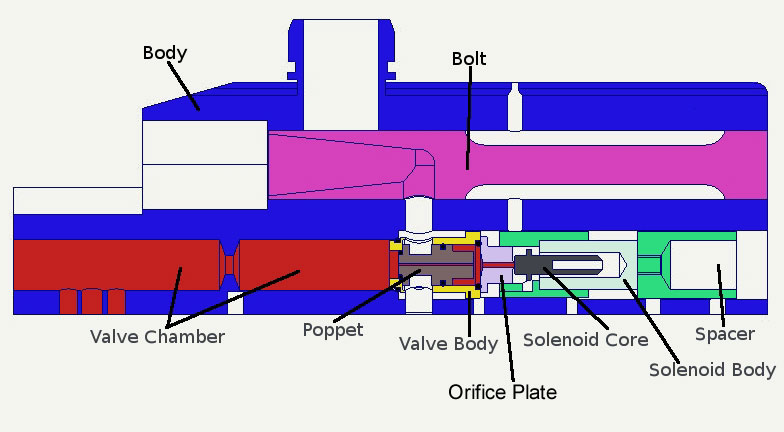 You
should note that there is a spring between the poppet and the orifice
plate, and the spring on the solenoid shaft that have been left out in
this diagram. No matter how I did it, having them in there cluttered up
the diagram, and made it very hard to understand how the pressure was
working. They are there in real life, the diagram is not 100% accurate. One of the missing springs fits between the poppet, and the orifice plate. This spring gives the poppet a push once the pressure has dropped on both sides of the poppet as the ball fires. The second spring sits around the solenoid shaft, pushing the shaft against the orifice plate. This creates the seal on the orifice plate when the system is at rest. Let's take the air pilot part first. In the case of most mechanical guns, the movement of the trigger releases the sear. That allows the hammer to be driven forward by the main spring, eventually hitting the valve stem, and opening the valve. On mechanical guns that have been upgraded to electronic frames, that linkage is still there, and is still being used. In the case of a cocker, an electronic solenoid is used to lower the sear, and thus replaces the mechanical movement of the trigger. The problem is you still have to create enough force on the sear to overcome the drag of the sear on the hammer lug. The stiffer the main spring is, the more force will be required, and the fewer shots you will get out of a battery. On the MQ, that mechanical linkage is removed completely. The sear solenoid, sear, sear spring, and the mechanical action of the hammer lug catching on the sear are all replaced by changing the pressure in the valve body it's self. This pressure change being used to move things is called an air pilot. When the air pilot activates, it uses a small amount of electricity from the battery to power the solenoid. The solenoid shaft is then pulled away from the orifice plate, allowing it to vent the pressure in the rear of the poppet. Now, since the pressure being vented already wants out, there is much less power needed to compress the spring around the solenoid shaft. The solenoid doesn't have to compress the spring by it's self, the pressure is already pushing against it, and helping to open the seal. By only using a small solenoid, and having the pressure do most of the work, the mQ saves battery life in a big way. Think of it this way: The air pilot is like a three way valve on a mechanical cocker. It only takes a little energy to move it, but you are changing the pressure balance in the system, and allowing the system to do the work for you. Now, the weird part, the balanced piston.... OK, let's forget about the MQ for a minute, and look at a plain old cocker ram. You put pressure into one side, and the shaft moves out. You empty the one side, and pressurize the other side, and the shaft moves in. That is what is used to cock, and load our guns. So, what happens in you put pressure on both sides at the same time? Logic would say the ram shaft would go to the middle of the travel, and stop there. Well, logic may say that, but a simple test says logic is wrong. The surface of the ram's piston has different working surfaces on each side, because of the ram shafts end is outside of the ram, the air pressure can't use it to generate force. Pressure can only create force when it is working against a surface. The more surface something has, the greater force any set pressure will be able to create. The more pressure applied, the more force generated on that surface. OK, now that my poor writing has confused the hell out of most people, take a look at this example: 
 On
the left-hand side, there is 100 SI pushing against a surface of 1/2
inch square. On the right hand side, there is a pressure of 50 PSI
pushing against a surface of 1". To figure out the force generated by a
certain pressure against a certain surface, just multiply the pressure
in PSI by the surface area in square inches. In both cases, it comes out to 50lbs of force being created, so the piston will sit in the middle if both sides are pressurized at the same time. So, what does all of this have to do with the MQ? Simple, the poppet in the mQ is a balance piston. Air pressure is applied to both sides of the poppet, and the difference in the surface area forces the valve to seal. Now that you know how each part of the system works, here is how they both work together: The parts listed do the following jobs: Valve Body: Holds the poppet, seals against the body of the gun, and the orifice plate. Poppet: Seals against the valve body, and moves to allow air into the bolt to fire the ball. Poppet Spring: Provides force to push the poppet closed after the pressure has dropped from behind it. Orifice Plate: Seals the back of the valve body, provides a small diameter air passage for the solenoid to seal. Solenoid Body: Holds the solenoid, allows pressure to vent from the rear of the valve body. Solenoid Core: Seals the back of the orifice plate, moves to allow air to vent from the read of the valve body Solenoid Core Spring: By pushing the solenoid core against the orifice plate, it creates the seal while the valve is at rest. Spacer: Holds everything in, and provides the force needed to seal the valve body to the gun body. Here is a close up of the valve installed in a gun, and pressurized. The red in the valve chamber is 300 PSI or so. 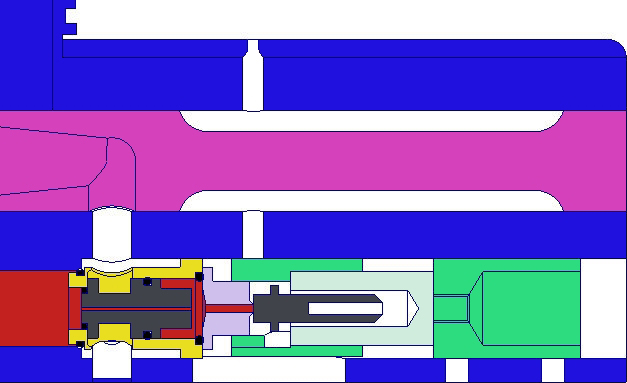 You
can see that the front of the poppet seals off the valve chamber form
the air passage to the bolt, but it also allows pressure through the
center, and into the chamber on the other side of the poppet. That is
what creates the different surface areas that are used to hold the
valve closed. The surface of the poppet on the back end is larger than
the sealing surface on the front, so the back creates more force with
the same amount of pressure, pushing the valve closed to seal it. MQ at rest:  At this point, the poppet is being held closed by a combination of the spring between the poppet and the orifice plate (which is also not shown), and the air pressure behind the poppet, but mostly by the air pressure. Step One: 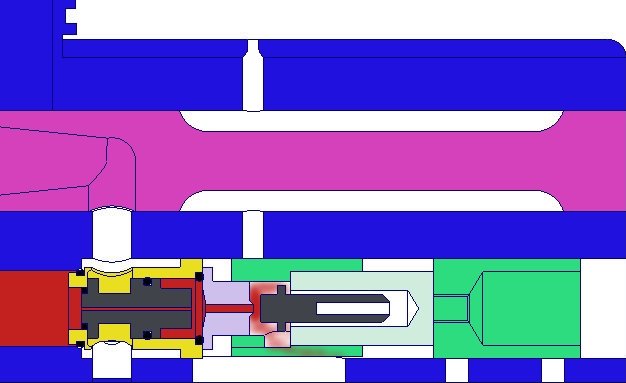 Step 2: 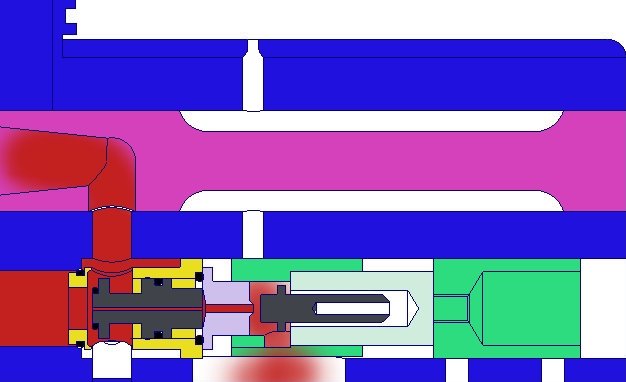 Step 3: 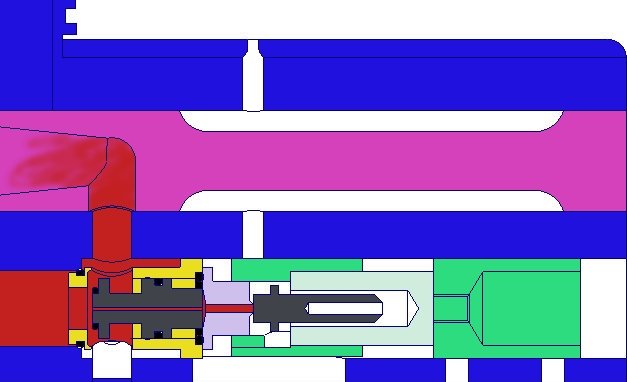 Step 4:  In these diagrams, it's shown as a one, two, three, type of system, but it really isn't. As soon as the pressure at the back of the poppet starts to drop, the poppet starts moving, and as soon as that pressure is reapplied, it starts to close, with the help of the spring. Also, as soon as the pressure in front of the poppet starts to bleed out to the bolt, the poppet slows down, because the spring is also pushing it forward as the same time. In short, step 1 overlaps the start of step 2, which overlaps the start of step 3, which overlaps the return to the resting positions. Here is the small file sized version of the mQ animation: 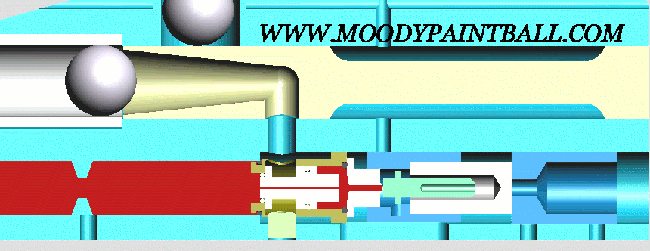
|